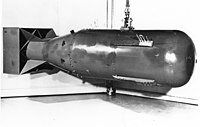
Photo from wikipedia
Purpose The purpose of this study is to evaluate how accurately a 3D printer could manufacture basic porous models. Geoscience research is evolving toward numerical prediction of porous rock properties,… Click to show full abstract
Purpose The purpose of this study is to evaluate how accurately a 3D printer could manufacture basic porous models. Geoscience research is evolving toward numerical prediction of porous rock properties, but laboratory tests are still considered a standard practice. 3D printing digital designs of porous models (proxies) is a way to bridge the gap between these two realms of inquiry. Design/methodology/approach Digital designs of simple porous models have been 3D-printed on an inkjet-style (polyjet) 3D printer. Porosity and pore-throat size distribution of proxies have been measured with helium porosimetry, mercury porosimetry and computed tomography (CT) image analysis. Laboratory results on proxies have been compared with properties calculated on digital designs and CT images. Findings Bulk volume of proxies was by 0.6-6.7 per cent lower than digital designs. 3D-printed porosity increased from 0.2 to 1.9 per cent compared to digital designs (0-1.3 per cent). 3D-printed pore throats were thinner than designed by 10-31 per cent. Research limitations/implications Incomplete removal of support material from pores yielded inaccurate property measurements. The external envelope of proxies has been 3D-printed at higher accuracy than pores. Practical implications Characterization of these simple models improves understanding of how more complex rock models can be 3D-printed accurately and how both destructive (mercury porosimetry) and non-destructive (CT and helium porosimetry) methods can be used to characterize porous models. Originality/value Validation of 3D-printed porous models using a suite of destructive and non-destructive methods is novel.
Journal Title: Rapid Prototyping Journal
Year Published: 2018
Link to full text (if available)
Share on Social Media: Sign Up to like & get
recommendations!